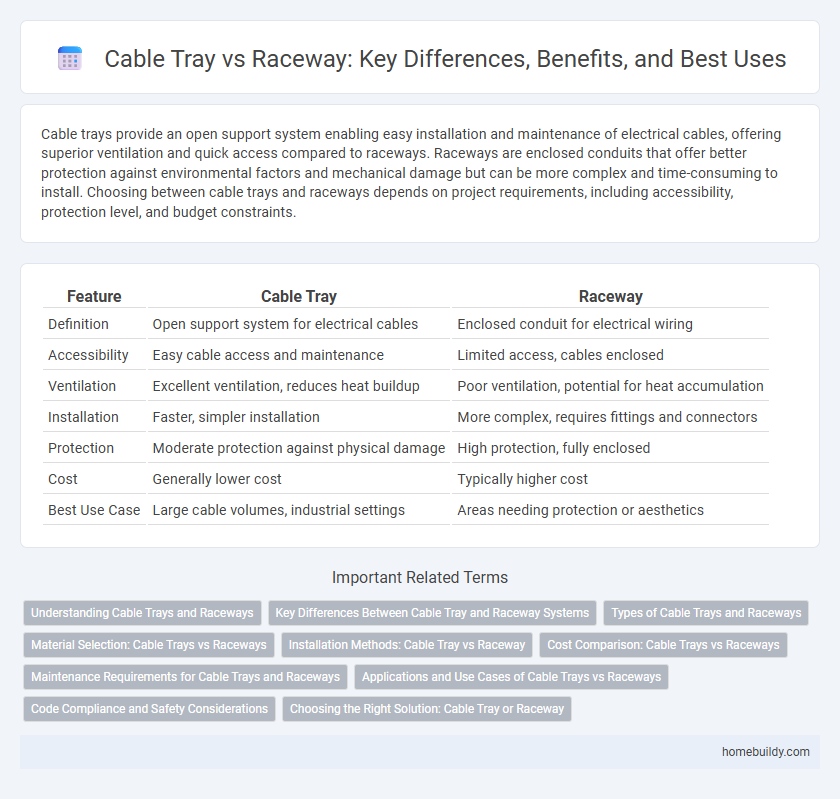Cable trays provide an open support system enabling easy installation and maintenance of electrical cables, offering superior ventilation and quick access compared to raceways. Raceways are enclosed conduits that offer better protection against environmental factors and mechanical damage but can be more complex and time-consuming to install. Choosing between cable trays and raceways depends on project requirements, including accessibility, protection level, and budget constraints.
Table of Comparison
| Feature | Cable Tray | Raceway |
|---|---|---|
| Definition | Open support system for electrical cables | Enclosed conduit for electrical wiring |
| Accessibility | Easy cable access and maintenance | Limited access, cables enclosed |
| Ventilation | Excellent ventilation, reduces heat buildup | Poor ventilation, potential for heat accumulation |
| Installation | Faster, simpler installation | More complex, requires fittings and connectors |
| Protection | Moderate protection against physical damage | High protection, fully enclosed |
| Cost | Generally lower cost | Typically higher cost |
| Best Use Case | Large cable volumes, industrial settings | Areas needing protection or aesthetics |
Understanding Cable Trays and Raceways
Cable trays provide an open support system for electrical cables, allowing easy access for maintenance and ventilation, while raceways are enclosed conduits that protect cables from environmental hazards and physical damage. Cable trays are typically used in industrial settings where large volumes of wiring require organization and flexibility, whereas raceways are preferred in environments demanding higher protection and a cleaner appearance. Choosing between cable trays and raceways depends on factors like installation environment, cable type, and required accessibility for future upgrades.
Key Differences Between Cable Tray and Raceway Systems
Cable trays offer open support for cables, providing easy access for maintenance and cooling, whereas raceways are enclosed conduits that protect cables from external damage and environmental factors. Cable trays are ideal for managing large volumes of cables in industrial or commercial settings, while raceways are preferred for applications requiring additional mechanical protection and aesthetic concealment. Material options differ; cable trays often use metal or fiberglass, and raceways typically utilize metal, plastic, or fiberglass to suit specific installation needs.
Types of Cable Trays and Raceways
Cable trays come in various types such as ladder, perforated, solid bottom, and wire mesh, each designed for specific cable management needs and environments. Raceways include metal, plastic, and surface-mounted ducts, providing enclosed pathways for electrical wiring with added protection against physical damage. Selecting between cable trays and raceways depends on installation requirements, cable types, and the level of accessibility or protection needed.
Material Selection: Cable Trays vs Raceways
Cable trays are typically made from materials such as steel, aluminum, or fiberglass, offering high durability and corrosion resistance for supporting heavy cable loads in industrial environments. Raceways often utilize PVC or metal conduit, providing more enclosed protection ideal for sensitive or hazardous areas where cables require isolation from external elements. Material selection between cable trays and raceways depends on factors like environmental conditions, mechanical strength needs, and ease of installation for specific electrical infrastructure projects.
Installation Methods: Cable Tray vs Raceway
Cable tray installation typically involves laying trays along walls or ceilings with support brackets, allowing easy access and modifications for cable management. Raceway systems require enclosed conduit placement, which involves more complex routing and securing, often demanding additional fittings and connectors. Cable trays offer faster and more flexible installation compared to the more labor-intensive and enclosed raceway methods.
Cost Comparison: Cable Trays vs Raceways
Cable trays generally offer a more cost-effective solution compared to raceways due to lower material and installation expenses, especially in large-scale projects. Raceways often require additional fittings, labor-intensive installation, and higher maintenance costs, which can increase the overall expenditure. Choosing cable trays can result in significant savings through simplified installation and greater flexibility for cable management.
Maintenance Requirements for Cable Trays and Raceways
Cable trays require periodic cleaning to prevent dust accumulation and visual inspections to check for corrosion or mechanical damage, ensuring secure cable support and ventilation. Raceways demand more frequent access for wire pulling and maintenance due to their enclosed design, often needing panel removal for inspection or repairs. Both systems benefit from scheduled maintenance to uphold electrical safety standards and prolong infrastructure lifespan.
Applications and Use Cases of Cable Trays vs Raceways
Cable trays are widely used in industrial and commercial applications for supporting large volumes of heavy electrical and data cables, offering easy cable access and superior ventilation. In contrast, raceways are preferred in residential and office environments where aesthetic concealment and protection from physical damage are crucial. Cable trays excel in handling extensive wiring systems in manufacturing plants, data centers, and power plants, while raceways are ideal for smaller, enclosed cable runs requiring more controlled environments.
Code Compliance and Safety Considerations
Cable trays and raceways differ significantly in code compliance and safety considerations, with cable trays often preferred for their superior ventilation, allowing heat dissipation and reducing fire risks as outlined in NEC Article 392. Raceways provide increased physical protection against environmental hazards and mechanical damage, meeting strict grounding requirements specified in NEC Article 300. Both systems require adherence to National Electrical Code (NEC) standards to ensure safe installation, with cable trays typically requiring careful load rating assessments and raceways focusing on secure conduit fittings to maintain system integrity.
Choosing the Right Solution: Cable Tray or Raceway
Choosing the right solution between cable trays and raceways depends on the installation environment and cable management requirements. Cable trays offer open support ideal for large volumes of cables with easier accessibility and ventilation, while raceways provide enclosed protection suitable for sensitive or hazardous environments. Evaluating factors such as cable type, maintenance needs, and safety standards ensures optimal performance and compliance.
Cable tray vs raceway Infographic

 homebuildy.com
homebuildy.com